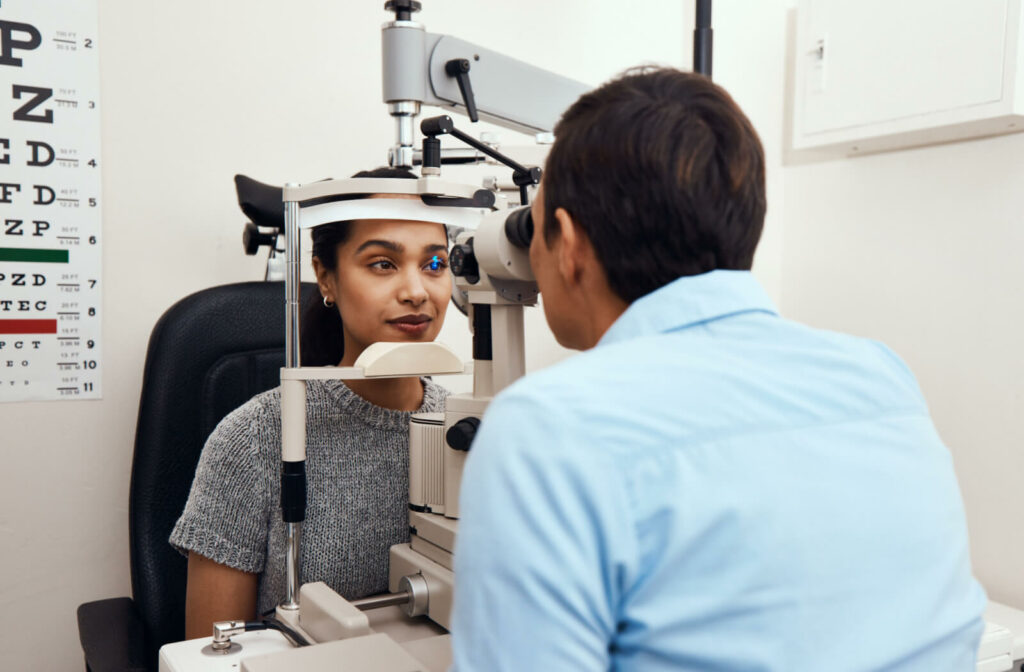Lazy eye, or amblyopia, is a common vision disorder caused by a communication error between the brain and the eye, leading to severe vision problems in 1 eye. While this condition affects millions of people, there is good news—lazy eye can be diagnosed and treated with the help of an optometrist.
Lazy eye can be treated at any time, but treatment can be much more effective in earlier years. This is due to the eye and the surrounding bodily systems being much more flexible in youth, making it easier to address the symptoms and train the brain and eye to work together.
While it is possible to treat lazy eye in later years, treatment may be less effective or take longer to show promise. Typically, an optometrist will recommend eyeglasses, contact lenses, eye drops, or an eyepatch to force the lazy eye to communicate with the brain.
What Is Lazy Eye?
Lazy eye, also known as amblyopia, is an eye condition that usually develops early in childhood. It occurs when the eyes develop differently, leading to 1 eye being weaker than the other. This causes a breakdown in communication between the weaker eye and the brain.
This communication issue leads to the brain subconsciously ignoring or neglecting the weak eye through a process called suppression—where visual information is ignored and vision from the other eye is prioritized. Over time, this can lead to the weaker eye being completely ignored by the brain, where it then begins to wander or look in a different direction than the stronger eye.
This condition can be diagnosed by an optometrist during a routine eye exam and is considered more treatable the earlier it’s noticed.
The Symptoms of Lazy Eye
The signs and symptoms of lazy eye vary from person to person but typically include:
- Poor depth perception
- Misalignment of the eyes
- Double vision
- Constant squinting
- 1 eye wandering
- Bumping into objects (particularly on one side)
Many of these are caused due to the lack of proper depth perception, as the brain ignores the visual information needed to navigate your environment properly.
How Is Lazy Eye Treated?
Treatment for lazy eye typically involves treating an underlying condition that causes lazy eye.
Refractive errors are common and can contribute to lazy eye, so treatment may include eyeglasses or contact lenses to correct the refractive error. Depending on the cause of your lazy eye, these treatments may be able to slow or stop the worsening of the weaker eye.
Other treatments can include:
- Eye drops designed to blur the strong eye, forcing the brain to rely on the weaker eye and strengthening the connection between the weak eye and the brain
- The use of an eye patch to force the brain to use the weak eye as the sole source of vision
By obscuring the stronger eye, the brain needs to rely on the weaker eye, stimulating its development and counteracting the suppression caused by lazy eye. In some cases, an optometrist may recommend vision therapy to train the eye and brain to work together.
What Happens if You Don’t Treat Lazy Eye?
If left untreated, lazy eye can have long-term consequences. As the condition progresses, the connection between the brain and eye deteriorates further and can lead to permanent vision loss in 1 eye.
Without treatment, the brain may begin to rely solely on the stronger eye. This can lead to a significant decline in vision, even if total vision loss doesn’t occur. It’s important to note that this condition progresses at different speeds depending on the person, so regular eye exams are key in monitoring the condition.
While it’s recommended to treat the condition as soon as it’s diagnosed, it’s rarely considered “too late” to treat lazy eye. Even though the eyes and brain become less flexible with age, they can still benefit from treatment and vision therapy. However, the success of the treatment depends on a few factors, including:
- Whether treatment is regularly continued
- The age of the person receiving treatment
- The severity of the condition
- The underlying cause of the condition
It’s generally recommended that treatment be started as soon as a diagnosis is received, as the connection between the eyes and brain is still strong in the earlier stages of lazy eye.

Getting Treatment for Lazy Eye
If you believe you or a loved one are developing lazy eye, or have been experiencing this condition for some time, your first step should be to visit an optometrist for a comprehensive eye exam. They can perform a thorough examination of your eye and may be able to determine what’s causing your vision problems.At Dr. Zargar Eyecare, we offer several treatment options for lazy eye, and our team of experienced eye care professionals is here to help you. Whether it’s through our vision therapy program, the use of eye drops, or specialty lenses, you can get help for your lazy eye and begin treatment. Schedule an appointment with us today and get the care and attention you deserve!

